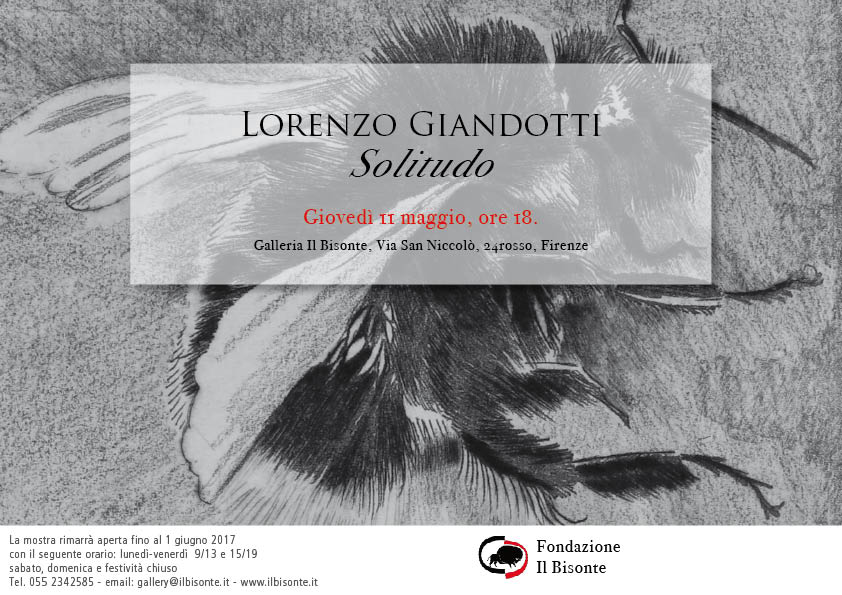1st of May 2017. Opening 11 May 2017 LORENZO GIANDOTTI Solitudo Il Bisonte Gallery, Via San Niccolò, 24rosso, Florence The exhibition will remain open until June 1, 2017 with the following opening hours: Monday-Friday 9/13 and 15/19, Saturday by appointment, Sunday closed Tel. 055 2342585 – email: gallery@ilbisonte.it – vecchio.ilbisonte.it Extracts from the...
ExhibitionsLorenzo Giandotti – Solitudo

1st of May 2017.
Opening 11 May 2017
LORENZO GIANDOTTI
Solitudo
Il Bisonte Gallery, Via San Niccolò, 24rosso, Florence
The exhibition will remain open until June 1, 2017
with the following opening hours: Monday-Friday 9/13 and 15/19, Saturday by appointment, Sunday closed
Tel. 055 2342585 – email: gallery@ilbisonte.it – vecchio.ilbisonte.it
Extracts from the two texts accompanying the catalog:
… In his “Pictorial Journey”, presented in 2011, I wrote – and today I am even more convinced – that Lorenzo Giandotti refers us to a noble and uninterrupted iconography, with a truly unique discretion (his “deafening silences”), with one of his lyric solitudo that accompanies us towards an urbanitas that we believed definitively lost. Finally, a consideration on the “Hornet”: a beautiful engraving and very dear to the Author. The Bumblebee – ceramolle / drypoint, like many other graphics here, is an intriguing insect: it is what we used to call “bumblebee” when we were young due to its heavy body with small wings. The “bombus terrestris”, recalled in Bilenchi’s narration, for which, it seems that Einstein had this to say that “the structure of the hornet, in relation to its weight, is not suitable for flight, but he does not know it and flies anyway … “. Here, I would entrust the meaning of this exhibition to this involuntary “ethical” message of the hornet: an artistic testimony with a great civil power, which still believes, despite everything, in the salvation of our civilization …
Francesco Gurrieri
Academy of Drawing Arts
…Mi pare questa la prima riflessione da fare in rapporto alle incisioni che Il gelo ha suscitato in Giandotti: sono queste prove di una scrittura grafica come la cera molle, essenziali nella loro stesura in cui si cerca di unire l’evocazione della memoria alla rappresentazione del segno e dei chiaroscuri. E quindi queste incisioni segnano più il tempo interiore dell’artista che non quello del racconto, che si compie non in una rappresentazione descrittiva, in cui nel romanzo, la trama costituisce il centro, quanto nell’apparire di singole immagini tra loro correlate quali fantasmi della memoria evocati dall’emozione vissuta. L’incisione si sa è un linguaggio grafico che non consente divagazioni come nella scrittura può essere la “prosa d’arte”, ma costringe il pittore a un lavoro duro, sciogliere l’immagine dai dettagli inutili della descrizione, fissare come in una radiografia l’essenza delle cose.
L’esempio più alto di questo linguaggio rimane, nella cultura artistica del nostro Novecento, quell’opera capitale che sono le incisioni di Giorgio Morandi, che ha condotto la tecnica dell’acquaforte allo stesso livello di espressione raggiunto dalla sua pittura.
L’incisione è stata per Giandotti la forma parallela, non minore di espressione a quella della pittura, ed egli da anni, con una costanza e un rigore che è difficile ritrovare nei suoi contemporanei, svolge il suo discorso, la costituzione in immagini delle sue emozioni, sia nella prima che nella seconda, nel suo linguaggio unico di sintesi attraverso l’immagine di rievocazioni che fondono emozione e memoria. Pochi pittori contemporanei hanno saputo fare altrettanto…
Marco Fagioli
… This seems to me the first reflection to make in relation to the engravings that Il gelo aroused in Giandotti: these are the proofs of a graphic writing such as soft wax, essential in their drafting in which we try to combine the evocation of memory to the representation of the sign and chiaroscuro. And therefore these engravings mark more the artist’s inner time than that of the story, which takes place not in a descriptive representation, in which in the novel, the plot constitutes the center, but in the appearance of single images related to each other such as ghosts of memory evoked by the emotion experienced. Engraving is known to be a graphic language that does not allow for digressions as in writing can be the “prose of art”, but forces the painter to work hard, loosen the image from the useless details of the description, fix it as in an x-ray the essence of things.
The highest example of this language remains, in the artistic culture of our twentieth century, that capital work which are the engravings of Giorgio Morandi, who led the etching technique to the same level of expression reached by his painting.
Engraving was for Giandotti the parallel form, not less of expression than that of painting, and for years he, with a constancy and rigor that is difficult to find in his contemporaries, has been carrying out his discourse, the constitution in images of his emotions, both in the first and in the second, in its unique language of synthesis through the image of re-enactments that blend emotion and memory. Few contemporary painters have been able to do the same …
Marco Fagioli
